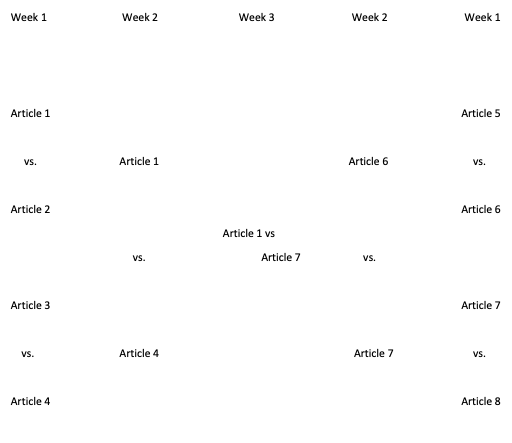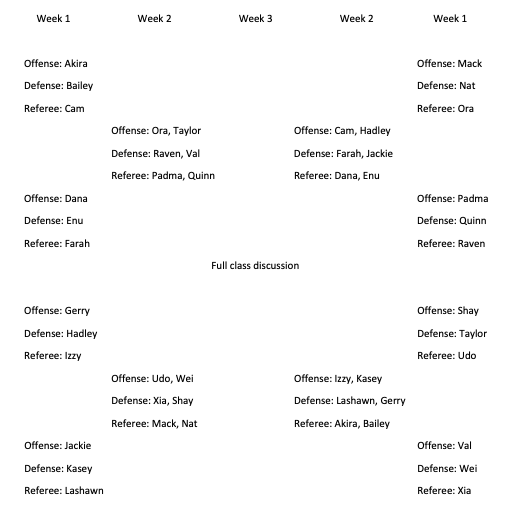16 March Madness: Putting it all Together
| Prerequisite Knowledge |
|
| Learner Setting | Classroom; online |
| Strategy Type | Small group; discussion; debate; journaling |
| Time | Varied; this assignment spans three weeks and integrates both online and in-seat class sessions |
| Learning Objectives |
|
| Materials/Resources | Articles (see below)
Assignment prompts (see below) Secret bias cards (see below) Sample bracket (see below) Sample assignments (see below) |
| Strategy Overview | In this innovative learning activity that mirrors an athletic tournament, students are engaged and motivated to apply the knowledge they have gained during the course in a collaborative and competitive way.
Using eight pre-selected research articles on an appealing topic immediately of use to the students – reducing test anxiety in nursing students – a competition “bracket” is created in which students are assigned to play offense, defense, or referee on the articles. The first week of the assignment is an online week in which the students present and judge critiques in small-group discussion boards. The second week is in-seat, and the students each have new roles, including secretly biased referees. There is a structured debate in class, critiquing the four “winning” articles from the previous week. The third and final week is online and involves individual reflective journals in which students share their own assessment of which of the final two articles should be declared the “winner” as well as their reflection on how they have met the learning outcome tied to this assignment. As it is written, this assignment is designed for 24 students. It can be adapted to smaller or larger groups by adding or subtracting articles or adjusting the number of students per role. |
| Steps |
|
| Evaluation | Moderate stakes – both graded and ungraded feedback over the three week period |
March Madness: Articles
Berube, C.A. & Gouveia, J. M. (2015). An academic support strategy: The “magic pencil.” Nurse Educator, 40, 276-277. http://doi.org/10.1097/NNE.0000000000000197
Johnson, C.E. (2014). Effect of aromatherapy on cognitive test anxiety among nursing students. Alternative and Complementary Therapies, 20, 84-87. http://doi.org/10.1089/act.2014.20207
Lai, H.-L. (2006). A preliminary study of music effects on nursing students’ test anxiety. International Journal of Human Caring, 10, 85.
Patterson, S.L. (2016). The effect of emotional freedom technique on stress and anxiety in nursing students: A pilot study. Nurse Education Today, 40, 104-110.
Prato, C.A. & Yucha, C.B. (2013). Biofeedback-assisted relaxation training to decrease test anxiety in nursing students. Nursing Education Perspectives, 34, 76-81.
Sharif, F., Dehbozorgi, R., Mani, A., Vossoughi, M., & Tavakoli, P. (2013). The effect of guided reflection on test anxiety in nursing students. Nursing and Midwifery Studies, 2, 16-20. http://doi.org/10.5812/nms.11119
Young, J.S. (2012). Pet therapy: Dogs de-stress students. Journal of Christian Nursing, 29, 217-221. http://doi.org/10.1097/CNJ.0b013e31826701a7
Zargarzadeh, M. & Shirazi, M. (2014). The effect of progressive muscle relaxation method on test anxiety in nursing students. Iranian Journal of Nursing and Midwifery Research, 19, 607-612.
March Madness: Week 1 (online) instructions
Defense assignment
You’re assigned as the defense for an article this week. The offense is going to attack your article, but your job is to protect it!
Read your assigned article thoroughly. Using what you’ve learned this semester, identify the following research steps in your assigned article and find all the strengths that you can in these ten areas:
- Problem and Purpose
- Literature Review
- Framework
- Variables
- Design
- Sample and setting
- Measurement
- Statistical Analysis
- Interpretation of Findings
- Implications for education, practice, or research
Post a summary on Blackboard that includes all of the strengths you’ve found in these areas so that the referees can make their decision. Do not only cite opinion. You must make specific reference to the material in the textbook/Key Points/Powerpoint.
Offense assignment
You’re assigned as the offense for an article this week. The defense is going to protect your article, but your job is to attack it!
Read your assigned article thoroughly. Using what you’ve learned this semester, identify the following research steps in your assigned article and find all the weaknesses that you can in these ten areas:
- Problem and Purpose
- Literature Review
- Framework
- Variables
- Design
- Sample and setting
- Measurement
- Statistical Analysis
- Interpretation of Findings
- Implications for education, practice, or research
Post a summary on Blackboard that includes all of the weaknesses you’ve found in these areas so that the referees can make their decision. Do not only cite opinion. You must make specific reference to the material in the textbook/Key Points/Powerpoint.
Referee assignment
- You’re assigned as the referee in the competition between two articles this week. Check Blackboard for your assigned articles, then read both articles and answer the following questions:
Study #1 Title: Yes No Was the study title clear? Was the abstract clearly presented? Was the writing style of the report clear and concise? Were relevant terms defined? Were the Introduction, Methods, Results, and Discussion sections clearly identified? Were the Introduction, Methods, Results, and Discussion sections clearly identified? Study #2 Title: Yes No Was the study title clear? Was the abstract clearly presented? Was the writing style of the report clear and concise? Were relevant terms defined? Were the Introduction, Methods, Results, and Discussion sections clearly identified? Were the Introduction, Methods, Results, and Discussion sections clearly identified? - After reading the two articles and completing the brief overviews above, read your peers’ offense and defense responses to the articles above on the Blackboard discussion board. Then write one paragraph justifying which article you think should win the competition. In other words, which article is overall stronger and provides better evidence (and why)?
March Madness: Week 2 (in-seat) instructions
Offense:
You’ll be assigned an article to critique for credibility and meaning (the final step of critical appraisal). You’ll work in pairs to answer the questions below, then the team captains (the ones who were referees last week) for offense and defense on each article will present your findings to your team of referees. Find as many weaknesses as you can!
Defense:
You’ll be assigned an article to critique for credibility and meaning (the final step of critical appraisal). You’ll work in pairs to answer the questions below, then the team captains (the ones who were referees last week) for offense and defense on each article will present your findings to your team of referees. Find as many strengths as you can!
The questions for offense and defense
- What rival hypotheses can be suggested for the findings?
- Do the findings from this study build on the findings of previous studies?
- When the findings are examined in light of previous studies, is the research gap improved?
- How confident are you in the validity of the study findings?
- Could the limitations of the study have been corrected?
- To what populations can the findings be generalized?
- What questions emerge from the findings, and does the researcher identify them?
- What implications do the findings have for nursing practice?
Referees:
You get to play the role of selection committee! In college basketball, the selection committee uses factors like record, strength of schedule, and rating percentage index (RPI) to determine the ranks or “seeds” of the teams. Although it’s after-the-fact, I would like to know how these articles stack up against each other. Which one is the “number one seed”? In this assignment, I would like you to work together to “seed” these articles (one through eight) based on criteria of your own choosing. For example, maybe you’ll decide that the strength of the method/design, the quality of the measurements of the variables, and the sample size are most important. Choose at least four criteria, scan the articles and make notes, then submit your final rankings by the end of week 3.
| Final Rank | Article | Notes |
| Berube & Gouveia
(pencils) |
||
| Johnson
(aromatherapy) |
||
| Lai
(music) |
||
| Patterson
(emotional freedom) |
||
| Prato & Yucha
(biofeedback) |
||
| Sharif et al.
(guided reflection) |
||
| Young
(dogs) |
||
| Zargarzadeh & Shirazi
(muscle relaxation) |
What criteria did you use to rank the articles?
Referees, you also have secret instructions for today’s class debate/discussion of our Final Four articles!
Like in sports where referees aim to be fair but naturally all have their own biases, there are biases in research. We’ve talked about bias with regard to research design, sampling, measurement methods, etc. This week, you’re also being introduced to forms of publication bias such as language bias, time lag bias, etc.
During today’s discussion you’ll each be assigned a secret bias – a filter through which to listen to your peers who play the roles of offense and defense. For instance, you might be biased toward creativity and that would influence you to vote for the article that presents the most creative intervention, data analysis, or implications. Or, you might be biased toward caution. In that case, you’ll be most swayed by the presentations of the offense and cast your vote toward the article with the least amount of negative points (no matter how many positive points are given)! I’ll be passing out cards with your secret biases on them, and you’ll be able to ask questions about them before the debate/discussion begins.
Secret biases to be written on notecards and one distributed to each referee:
- Data/facts
- Feelings/emotions
- Positive view, benefits
- Caution/judgment
- Creativity/new ideas
- Summaries/decisions
March Madness: Week 3 (online) instructions
All students:
Answer the following questions. Please write at least two sentences in response to each prompt:
- Which article should win March Madness and why?
- Which roles did you play during March Madness (offense, defense, referee, selection committee)? What did you like/dislike about these roles?
- What’s the most important thing you learned while completing March Madness and why?
- How did March Madness help you evaluate the strengths and weaknesses of different evidence?
- What question(s) has March Madness raised for you? What are you still wondering about?
March Madness: Sample bracket

March Madness: Fictional student assignments

